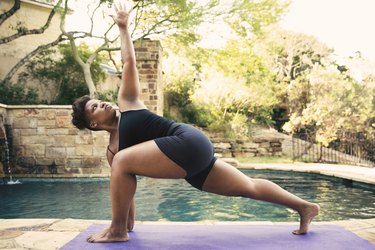
You likely don't need anyone to tell you this, but the American workforce is sitting more than ever. What you might need a little bit of help figuring out, though, is what to do about the aches and pains caused by hunching over your computer.
"Back problems are among patients' most frequent complaints to their doctors," according to Georgetown University's Health Policy Institute. "Nearly 65 million Americans report a recent episode of back pain. Some 16 million adults — 8 percent of all adults — experience persistent or chronic back pain, and as a result are limited in certain everyday activities."
Video of the Day
Video of the Day
Check out more of our 20-minute workouts here — we’ve got something for everyone.
The good news is that you may be able to counter these adverse effects of your desk jockey status and reduce your risk of back pain by adding yoga to your daily routine. In fact, in a July 2017 study in the Annals of Internal Medicine, researchers found that yoga was as effective as physical therapy for easing chronic back pain.
This 20-minute floor yoga sequence is the perfect place to start easing back pain from sitting all day. Plus, when done consistently, you'll also help prevent pain and promote balance and harmony in your body and mind. Move from one pose to the other timed with your breath.
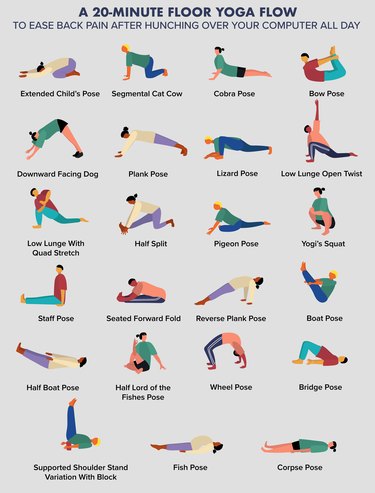
Move 1: Extended Child’s Pose (Utthita Balasana)
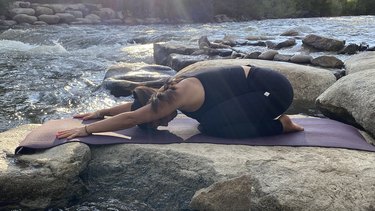
- Start on all fours. Bring your big toes together and knees slightly wider than hip-width apart.
- Extend your arms out in front of you and sit your hips back toward your heels.
- Rest your forehead on the mat and close your eyes.
- Breathe deeply for 5 to 10 breaths.
Tip
This pose helps you unwind, release stress and feel centered and grounded as you head into the following flow.
Move 2: Segmental Cat Cow
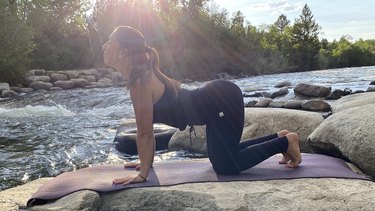
- Start on all fours with your knees under your hips and your hands under your shoulders.
- Draw your navel in toward your spine and arch your back up to the sky like a cat.
- Starting at your tailbone, begin to extend your spine, vertebrae by vertebrae, until your back is arched the other way — belly dipping toward the ground and head lifted up to look at the sky.
- Continue slowly alternating between the two for 5 breath cycles (inhale, exhale).
Tip
Unlike your muscles, cartilage has no direct blood supply, so the health of your joints is dependent on movement. To get your back mobile and healthy, it's important to move the joints of the spine in order to release synovial fluid to reduce friction and improve ease of movement.
Move 3: Cobra Pose (Bhujangasana)

- Lie on your stomach with legs together, tops of the feet down and hands under your shoulders.
- With an inhale, peel the chest away from the floor.
- Roll your shoulders back and down your spine as you begin to straighten the arms as your flexibility allows.
Tip
Cobra pose strengthens your back muscles while opening the shoulders and chest and stretching the abdomen and hip flexors.
Move 4: Bow Pose (Dhanurasana)
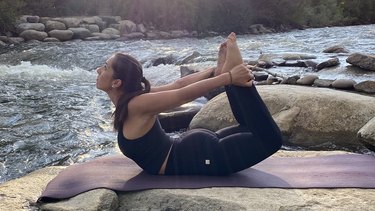
- Lying on your stomach, bend your knees so your feet come closer to your butt, peel your chest away from the mat and actively hold like you’re in Cobra pose as you reach behind you and grab the outside of your ankles.
- Kick your legs into your hands as you continue to lift your chest and feet upward.
Tip
Similar to Cobra pose, Bow pose strengthens the postural muscles and stretches the front of the body, but this pose also activates your hamstrings. It can also help improve digestion and aid in relaxation and mental concentration.
Move 5: Downward Facing Dog (Adho Mukha Svanasana)
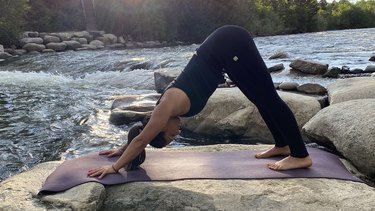
- Starting from all fours, curl your toes under and lift your hips up, straightening your legs.
- Draw your shoulders down your spine away from your ears. Elongate your spine and extend the backs of the legs only as far as the hamstrings allow.
- Depending on your flexibility, bring your heels down toward the mat or stay on the balls of your feet with knees bent.
Tip
Downward Facing Dog helps elongate the spine and provide traction in the neck, relieving built up tension. It also stretches the calves and hamstrings and builds strength in your shoulders.
Move 6: Plank Pose (Kumbhakasana)
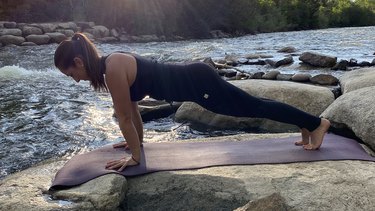
- Start on all fours, then step your feet back into a high plank. Make sure your hands are shoulder-width apart with your fingers facing forward.
- Stay on the balls of your feet, engage your legs, draw your navel to your spine and lengthen your tailbone toward your heels.
- Keep your neck in line with your spine.
Tip
Plank pose fires up your core, building strength from the inside out. It's an excellent prep posture for more difficult poses, as it creates stability throughout the body. A strong core also helps protect your back from unnecessary stress.
Move 7: Lizard Pose (Utthan Pristhasana)
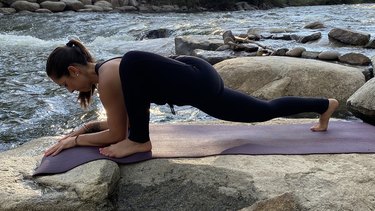
- From Plank pose, step your right foot forward on the outside of your right hand. Keep the left leg extended. Aim to keep the hips square and core engaged.
- Hold and breathe as you explore your range of motion.
- You have the option to stay on the hands or lower down on the elbows as your hips begin to open up.
Tip
Sitting in a chair for an extended period of time shortens the hip flexor muscles and weakens the glutes. Over time, you begin to lose range of motion through the hips due to lack of use and the back picks up the slack, creating pain and increased risk of injury. This pose helps to load the front hip in hip flexion while the back leg stays engaged and stretches the hip flexors while activating the glutes.
Move 8: Low Lunge Open Twist
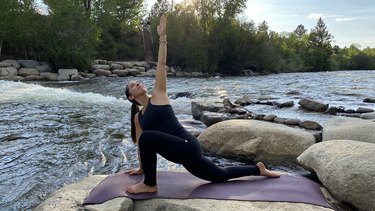
- From Lizard pose, come up to your hands (if you were on elbows).
- Shift your weight into your left hand, twist and extend your right hand up toward the sky.
- Aim to keep your hips square, engage the pelvic floor muscles, and let the twist come from your mid-spine.
Tip
Working at a computer can create excessive rounding of the upper back and internal rotation of the shoulders. This pose helps you reclaim mobility around the mid-spine as you extend and twist.
Move 9: Low Lunge With Quad Stretch
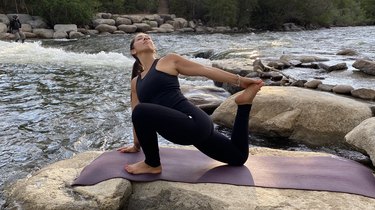
- From the previous pose, bend your left knee and reach your right hand back to grab the foot.
- Kick your foot into your hand to open the chest and shoulder more.
Tip
This pose is an all-in-one excellent stretch for your entire body if you’ve been slumped over a desk all day. It opens your chest and shoulders, hip flexors, abdomen and quadriceps. You also receive the dynamic movement of a twist and activation of your hamstrings and back muscles to support good posture.
Move 10: Half Split (Ardha Hanumanasana)
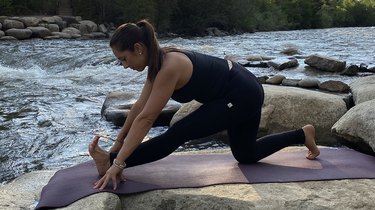
- From the previous pose, extend your front leg by sitting your hips back toward your heel. Keep the foot flexed and toes active.
- You have the option to place your hands on blocks to keep the torso elevated and/or maintain a slight bend in your knee.
Tip
This pose helps elongate the hamstrings and spine.
Move 11: Pigeon Pose (Eka Pada Rajakapotasana)
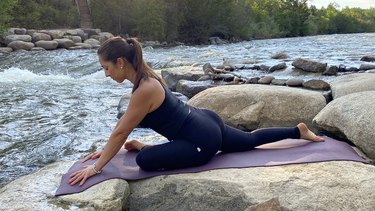
- From Half Splits, shift back into Low Lunge.
- Lift your back knee off the floor and walk your right foot toward your left hand so the shin is parallel to the front of the mat.
- Keep your foot flexed as you sit back to stretch the outer hip. Breathe deeply as you come to your end range of motion.
- From here, actively push your shin into the floor to strengthen the external rotators.
Tip
Balanced and strong external hip rotators can help mitigate back and knee pain. Pigeon pose stretches the muscles of the outer hip such as the piriformis and gluteal muscles, but you can also activate those muscles in this pose to make them stronger.
From Pigeon Pose, return to Downward Facing Dog and repeat poses 7 to 11 on the other side.
Move 12: Yogi’s Squat (Malasana)
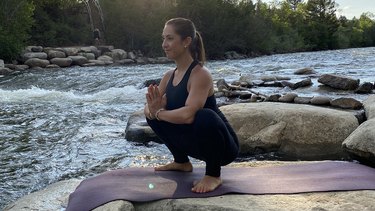
- With your knees hip-distance apart and your feet turned slightly out, bend your knees and sink your hips down.
- Maintain length in your spine as you lift your sternum, open your chest and relax your shoulders away from your ears.
- Bring your hands into a prayer position, gently pressing your elbows against your inner thighs.
Tip
Malasana helps open the hips and ankles, lengthen the groin and inner thighs and decompress the lower back. If you need to, roll your mat up and place it under your heels.
Move 13: Staff Pose (Dandasana)

- Take a seat on your mat with your legs straight out in front of you and together. Keep your feet flexed and active. Engage your quadriceps.
- Bring your hands by your sides along your hips either on the floor or on blocks.
- Sit up tall, stacking the vertebrae and engaging your core. Breathe with depth and ease.
Tip
Staff pose helps emphasize good seated posture. It strengthens the spinal erectors, stabilizes the core and builds awareness.
Move 14: Seated Forward Fold (Paschimottanasana)
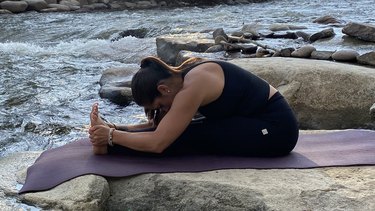
- Sit up tall with your legs together. Engage your quadriceps (tops of thighs) to lengthen your hamstrings. You can put a slight bend in the knees.
- Hinge at your hips and reach for your shins, ankles or toes while maintaining a long spine. You'll feel the stretch at the top of the hamstrings rather than the low back.
Tip
Forward folds such as Paschimottanasana stretch the back line of the body and also induce a feeling of calmness and relaxation, so it feels great after a long day of work.
Move 15: Reverse Plank Pose (Purvottanasana)
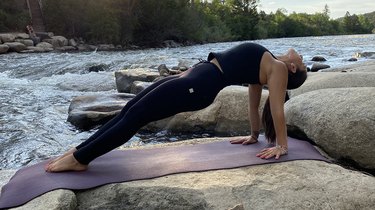
- From Dandasana, place your hands about one foot behind your hips with fingers facing forward (if you have sensitive wrists you can turn your hands out) and legs together.
- Press into your hands and feet and lift your hips and chest toward the sky. Maintain a straight line from shoulders to hips to feet — a plank flipped over.
Tip
This pose strengthens the glutes while opening the shoulders and chest and elongating the spine.
Move 16: Boat Pose (Navasana)

- From a seated position, lean back on your sit bones. Your torso will be at a 45-degree angle to the floor
- Keep your chest lifted as you lift your feet off the floor, shins parallel to the ground.
- Stay here or extend your legs out straight, bringing your body into a V shape.
Tip
Boat pose is an excellent pose to strengthen your core and create total-body strength and coordination.
Move 17: Half Boat Pose (Ardha Navasana)
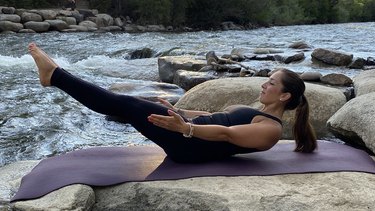
- From Boat pose, lower down with control, but keep your shoulders and feet off the ground.
- Squeeze your legs together. Maintain contact between your lower back and the mat by drawing your navel to your spine.
- Breathe, keep your face relaxed and hold without sacrificing your form.
Tip
Half Boat pose challenges your core, not only making your abs stronger, aiding in better posture and alignment, but also forcing your nervous system to level up as you gain mental strength and breathe through the shakiness this pose creates.
Move 18: Half Lord of the Fishes Pose (Ardha Matsyendrasana)
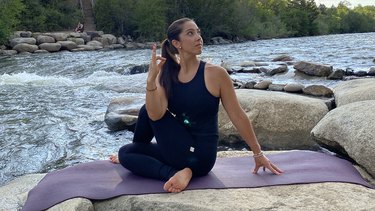
- From a cross-legged position, bring your right foot to the outside of the left thigh with your knee upward toward the sky. Turn toward your right knee.
- Place your right hand behind your sacrum keeping the torso upright and elongated.
- Inhale and lift the left arm up overhead, exhale and twist deeper as you hook the left elbow on the outside of the right thigh.
Tip
Repetitive movement patterns can create imbalances in the spine and lead to back, hip or neck pain. Practicing seated twists properly trains the body and mind to twist deeply while maintaining stability around the sacrum and maintaining extension through the spine.
Move 19: Wheel Pose (Urdhva Dhanurasana)
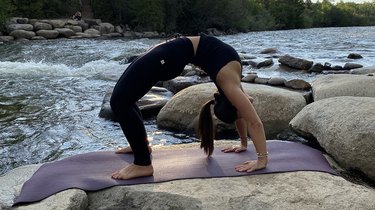
- Lie on your back with your knees bent and pointed up toward the sky.
- Bring your hands alongside your ears with your fingers slightly pointed outward to avoid pinching at the wrist.
- Press into your feet and your hands to lift your entire body up into an upside-down U shape, extending the hips and exploring movement in this position as you open the heart.
Tip
If you spend hours a day hunched over a computer, it’s important to move your spine the opposite direction to create health and balance. Wheel pose energizes the body, strengthens the legs, glutes, and back and opens the front side of the body making it easier to breathe fully and have more energy.
Modification: Bridge Pose (Setu Bandha Sarvangasana)
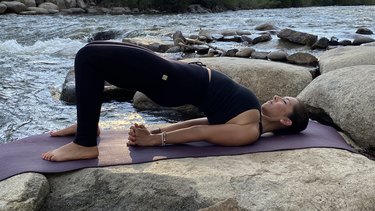
- Lie on your back with your knees bent and pointed up toward the sky.
- Tuck your shoulder heads beneath you, interlace your hands beneath your tailbone and lift the breast bone as you drive into your feet and engage your glutes.
- Lift your hips and back off the floor, creating a straight line from knees to shoulders.
Tip
Full wheel pose has a prerequisite of open shoulders to do the posture safely and comfortably. If your shoulders and upper back aren’t mobile enough to perform the pose safely, bridge pose is an excellent option.
For a more gentle version, try Bridge pose with a block. Supported bridge is a great alternative to help create length in the lower back. Place a block under the sacrum, relax on your back breathing deeply into your low abdomen and lower back.
Move 20: Supported Shoulder Stand Variation With Block

- Lie on your back and place a block under your tailbone.
- Lift the legs up toward the sky or lie on your back facing a wall and place your legs up the wall.
Tip
Shoulder stand is known for calming the mind, strengthening the entire body, improving digestion and energizing the body, but for someone who may have back pain or neck pain, the traditional version may not be a safe starting point. Supported shoulder stand with a block is an excellent way to receive many benefits of the pose without putting yourself at risk of injury.
Move 21: Fish Pose (Matsyasana)

- Lying on your back with your legs together and arms close to your body, slide your fingertips under your butt.
- Inhale as you arch your upper back and come onto the crown of your head.
- Hold and breathe.
Tip
Fish pose is the classical counterpose to shoulder stand. It opens the throat, strengthens the spine and calms the mind.
Move 22: Corpse Pose (Savasana)

- Lie on your back.
- Place a small pillow or rolled-up blanket under your head and/or a bolster under your knees if you want.
- Find length through your lower back and relax the pelvis and hips.
- Let your arms rest by your sides with your palms facing up.
- Breathe with ease and relax every part of your body.
Tip
Savasana is the final resting posture. It's an opportunity to relax the body, mind and spirit and integrate the effects of your practice into your life.